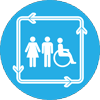Beyond Buckets and Pipes
2696 views
- BennyChabalaFilumba
-
 Topic Author
Topic Author- Public Health and WASH professional passionate about youth engagement, sanitation learning, and collaborative problem-solving. I enjoy supporting communities and practitioners through active moderation, capacity building, and impactful communication.
Less- Posts: 25
- Likes received: 13
Beyond Buckets and Pipes
Imagine walking miles for water, missing school because there's no toilet, or staying silent during your period because of shame. For millions of girls and women, this isn't fiction but rather it's life. And in the world of Water, Sanitation, and Hygiene (WASH), these experiences often go unheard. We talk about infrastructure like pipes, tanks and toilets but not the gender gaps in who uses them, who controls them, and who's left behind. Despite strong gender policies from the World Bank and UNICEF, action on the ground is somewhat still patchy. If we want WASH programs to work for everyone, gender can't be an afterthought. It must be the foundation.
The Quiet Crisis in WASH
Women and girls are often at the center of WASH such as fetching water, managing hygiene, and facing unique challenges to mention but a few. Apparently, their voices are missing when systems are designed. Many project evaluations mention 'gender', but fail to show how it's actually addressed. Too often, gender gets reduced to counting women at meetings without asking if they had a say. Worse, 'gender' becomes shorthand for 'women', ignoring boys, men, and non-binary people who also face barriers shaped by gender roles.
What's Holding Us Back?
From field surveys and evaluations, some common obstacles stand out:
Listen locally: Gender roles differ by context. One-size-fits-all doesn't work.
Measure meaningfully: Don?t just count women but rather to track impact.
Train teams: Gender inclusion should be a core skill.
Co-design projects: Bring diverse voices to the table early and often. When people of all genders are involved in shaping WASH services, programs work better and last longer.
Why It Matters
Ignoring gender costs us: in safety, in dignity, in development outcomes. Girls drop out of school. Women face violence at night. Men aren't engaged as hygiene leaders. But when we embed gender into every step design, delivery, and evaluation we unlock WASH systems that empower communities, not just serve them. Bottom Line - WASH isn't just about water and toilets. It's about power, participation, and equity. We don't need more promises. We need real action because gender equality isn't just good policy. It's smart WASH.
References:
Caruso et al. (2017). WASH and gender disparities.
UNICEF (2021). Progress on water, sanitation, and hygiene.
World Bank (2015). Gender in water and sanitation projects.
UN Women & UNICEF (2020). Integrating gender in WASH.
Imagine walking miles for water, missing school because there's no toilet, or staying silent during your period because of shame. For millions of girls and women, this isn't fiction but rather it's life. And in the world of Water, Sanitation, and Hygiene (WASH), these experiences often go unheard. We talk about infrastructure like pipes, tanks and toilets but not the gender gaps in who uses them, who controls them, and who's left behind. Despite strong gender policies from the World Bank and UNICEF, action on the ground is somewhat still patchy. If we want WASH programs to work for everyone, gender can't be an afterthought. It must be the foundation.
The Quiet Crisis in WASH
Women and girls are often at the center of WASH such as fetching water, managing hygiene, and facing unique challenges to mention but a few. Apparently, their voices are missing when systems are designed. Many project evaluations mention 'gender', but fail to show how it's actually addressed. Too often, gender gets reduced to counting women at meetings without asking if they had a say. Worse, 'gender' becomes shorthand for 'women', ignoring boys, men, and non-binary people who also face barriers shaped by gender roles.
What's Holding Us Back?
From field surveys and evaluations, some common obstacles stand out:
- Vague goals: 'Include women' is not a strategy.
- No tools: Many teams lack gender-sensitive monitoring.
- Old habits: Technical priorities override inclusion.
- Training gaps: Staff often don't know how to apply a gender lens. Even with the best intentions, progress stalls without clear guidance and support.
Listen locally: Gender roles differ by context. One-size-fits-all doesn't work.
Measure meaningfully: Don?t just count women but rather to track impact.
Train teams: Gender inclusion should be a core skill.
Co-design projects: Bring diverse voices to the table early and often. When people of all genders are involved in shaping WASH services, programs work better and last longer.
Why It Matters
Ignoring gender costs us: in safety, in dignity, in development outcomes. Girls drop out of school. Women face violence at night. Men aren't engaged as hygiene leaders. But when we embed gender into every step design, delivery, and evaluation we unlock WASH systems that empower communities, not just serve them. Bottom Line - WASH isn't just about water and toilets. It's about power, participation, and equity. We don't need more promises. We need real action because gender equality isn't just good policy. It's smart WASH.
References:
Caruso et al. (2017). WASH and gender disparities.
UNICEF (2021). Progress on water, sanitation, and hygiene.
World Bank (2015). Gender in water and sanitation projects.
UN Women & UNICEF (2020). Integrating gender in WASH.
Please Log in to join the conversation.
You need to login to reply
Share this thread:
Recently active users. Who else has been active?
Time to create page: 0.068 seconds







